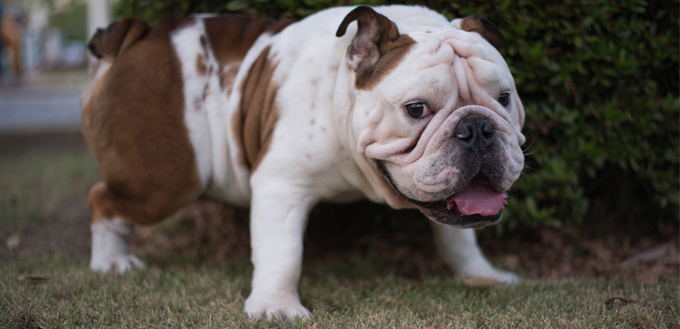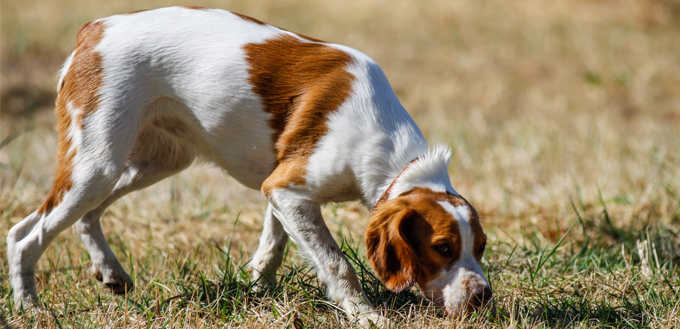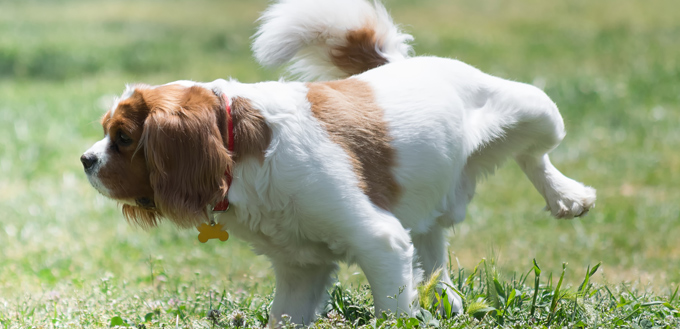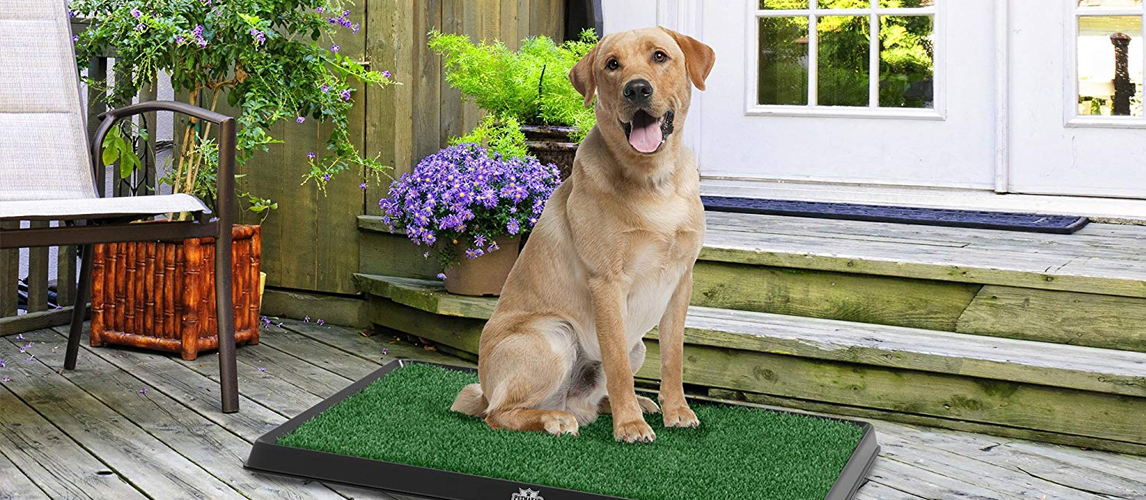General theories say that when peeing, male dogs would raise their leg, while female dogs are likely to squat. But don’t you think that’s way too general for a breed so big? That’s right, dogs have multiple peeing positions. Now comes the real question, why should you be bothered with this issue anyway? Well, a lot of the time, dog peeing positions can tell us a lot about our dog’s health condition, happiness and what’s going on inside their mind.

Whether you believe it or not, experts have conducted quite a number of studies on different postures of urination. Let’s take a look at different types of dog peeing positions and what they mean:
Dog Peeing Positions
- Stand: Standing on all-fours as they normally do
- Lean: The dog’s body leaned forward with their back legs extended towards the back. This position allows the dog to deposit their urine directly on the ground.
- Flex: The back legs of the dog are somewhat bent so their back end is lowered towards the ground. Usually, the neck is lowered.
- Squat: Their back assumes a steep sloping position, standing on their front legs while their back legs are tightly bent towards the ground.
- Handstand: The dog lifts up both their back legs off the ground and places those legs up against a vertical surface.
- Arch: The back legs are spread and their body curved to bring the back-end closer to the ground. They can also be seen to lift their tail away from the ground.
- Raise: The dog raises just one of their back leg off the ground to urinate. The other back leg is slightly bent.
- Elevate: This is similar to raise. Lifting one back leg off the ground while the leg is held tightly straight to balance their body weight. This is a more extreme position compared to raise.
- Lean-Raise: A dog’s version of a push-up, with one back leg raised above ground.
- Flex-Raise: Mostly in flex position with one hind leg hovering over the ground.
- Squat-Raise: Squatting with both hind legs above the ground.
- Arch-Raise: 90% true to arched position but one of the back legs is slightly raised.
In their long years of study, experts observed that female dogs mostly squat or go for the squat-raise position most of the time. Female dogs also use a variety of other postures as shown in the diagram as well. On the other hand, male dogs are more collected when it comes to peeing positions. Most male dogs show the elevated position and a few of them used the raised position. The squat-raise and lean-raise position were not noticed among male dogs at all.
A dog’s peeing positions is often looked up to as being a sexually dimorphic behaviour. Do notice how there are significant differences in dogs’ urinary positions based on their gender. Normally, it’s the males who lift their legs, whereas the females usually squat.
The difference between male and female dogs may not be too strange since just like us human beings, they too have their anatomical differences – with most men standing up to pee in front of the urinal bowl and ladies sitting on the toilet.
Analysts have concluded that male dogs lifting their leg is advantageous for them to directly urinate with precision on straight-up surfaces just so other dogs can examine the scent, whereby often “marking their turf”.
Understanding the Peeing Positions
Social Interacting for Dogs
We can never foresee the unpredictable behaviours of our furry friends. Dog enthusiasts have come up with a wide variety of theories among which, the most popular one explains that they do this to avoid peeing on themselves. Depending on the situation, and the place where they are at, they will adjust their peeing positions.
Personal Favourite Peeing Style
Yes, there’s a thing called dog’s personal favourite peeing style. Studies have shown despite their gender and regardless of the fact whether the dog is spayed or neutered, dogs sometimes choose to randomly squat or lift their leg when it’s time for their business. Plus, it also depends on how they were raised. According to American Society for the Prevention of Cruelty to Animals (ASPCA), if your four-legged boy doesn’t lift their leg to pee, he might not have been around a grown-up male dog to imitate the behaviour while he was at his physio-psychological development phase of life (around 8 – 12 months). Or if he grew up alone, spending most of his time at the backyard, he might not have felt the need to do this anyway.
When Squatting Becomes a Serious Issue
It’s mostly the female dogs that squat when they need to pee, but recent studies have shown that squatting in dogs could also mean an underlying medical illness, some of which includes arthritis, hormonal or neurological disorders or even an orthopaedic condition. Moreover, if you have recently started noticing your dog squatting, it might be telling you about their urinary incontinence. This is more common in adult dogs. Either way, take your boy for a thorough physical exam. Any problem shall be quickly recognized.
What Do the Positions Mean?
Now that we’ve addressed the peeing positions of a dog, the next most important question is “what does it exactly mean when a dog picks that particular position?”
Bear in mind that dogs urinate to serve two main purposes – marking their territory and elimination of body wastes. Despite their gender, they are both likely to scent mark. However, this behaviour is more prevalent in males. Dogs who mark preferentially, pee on vertical facades. Your dog knows that if he urinates higher on the surface, the pee would stream downwards, coating a bigger area and thus leaving a stronger scent to anybody who would pass by.
Another reason why male dogs aim higher while peeing is to make him seem bigger than he actually is. When a dog is attending call of nature, they feel vulnerable to attack. Interestingly enough, as dogs mature, they are likely to develop this leg-raising behaviour. On the other hand, the lean posture is typically adopted by younger puppies.
Anyhow, here are some more explanation on the dog peeing postures:
Male Leg Lifters
It might have previously driven you crazy wondering why your furry little boy needs to lift up his leg when he needs to pee. Although there are not many studies and theories that could convince you regarding this behaviour unless your boy could talk and explain it to you himself. But experts say most of the time, it’s a learned behaviour from their seniors.
Another reason why male dogs pee using this position is to have an effect on their testosterone hormones. This makes more sense in the case of intact male dogs who are being neutered. Other interpretations show that the dog’s tendency to scent mark reduces. Neutered dogs also lose their interest in squatting and as a result, they just stick to their old habit of leg lifting.
Standing and Peeing
If your dog randomly stands and pees everywhere you take him and comes back home to pee some more, he is purposefully marking his presence all over everywhere. On the contrary, the dog might as well be suffering from a urinary problem. Keep an eye on him, if this keeps repeating, you might get him checked by your vet ASAP. Maybe your little pet is under some sort of abdominal pain which prevents him from getting into a comfortable position.
Also, sometimes, dogs just fail to completely drain their bladder if the weather outside is too cold or raining. Therefore, they push themselves to come back home and empty their bladder.
Lifting only the Rear Leg
Generally, this position is only carried out with the help of nearby vertical surface/objects for support. This is a posture that is mostly taken up by males, while only a few of the female dogs squat as well as lift their rear legs to release their urine. Some dogs are quite pro at lifting both their rear legs when peeing (aka the handstand position). It’s mostly a playful position and no medical reasons are affiliated to it.

A Question of Social Maturity
Why is my dog urine marking everywhere?
Blame those hormones? Well, it’s actually more than that.
Of course, a male dog’s tendency to urine mark reduces gradually when they are finally neutered. However, dogs don’t just stop urine marking the next day they hit puberty. Therefore, it’s more than just sexual behaviour; it’s also about feeling the social maturity level from other dogs, as observed by dog behaviourists.
Fun Fact: When a puppy is born, they cannot pee or defecate on their own. During the early stages of their life, the momma dog licks and ingests their excrement until at least they are about 3 weeks old (Ranson, 1981).
Did you ever notice your dog marking his territory while hand-standing?
Well, we did! It might seem like the weirdest thing you’ll ever see your dog doing, but if you dig a little deeper, you’ll find out the reason behind your dog’s hand-standing position to pee.
Apart from their biological needs, as we mentioned earlier, they use pee to scent mark their territory. You’ll notice mostly puppies performing handstands while urinating. Again, it’s because they want to spray farther on vertical objects like trees, wall or fences to mark their scent.
And about female dogs… this is where the handstand position implies the most. This is said to be the best way for a female dog to pee to scent mark. Many research and studies support this hypothesis about female dogs. A study in 2004 revealed the different urinary behaviours of six intact and six spayed female Jack Russell Terriers. The results drew impactful outcomes. It showed that female dogs pee more frequently when they are taken outside their familiar territory. They are also likely to aim at objects compared to when they walk close to their house. Therefore, when female dogs urinate, it’s not just about elimination, it’s also about scent marking.
Therefore, when dogs take on a posture that hits their urine on an object above the ground’s surface, know that they are doing so to scent mark the turf.
In What Position Does Your Dog Pee?
Among the several different types of peeing positions that dogs have, which position does your dog choose? According to Sprague and Anisko (1973), they studied a group of beagles to find a dozen about this topic. Finally, they concluded that female dogs are more likely to use more variable peeing positions than male dogs. Call them innovative or just experimental-minded, it was found that female dogs change up to eight positions, while male dogs change up to four.
Did You Know: It is not unusual to be able to find little amounts of testosterone in your female dog’s urine. They do produce this hormone that plays an important role in their reproductive system.
Is My Dog Urinating or Marking?
Both. In most cases, it’s not just about emptying their bladder, it’s also about marking their existence. Here are some more observations that will help you understand if your dog is marking or urinating:
- Territorial Marking: This is just their way of telling “Mr Doggo resides here”, or in other words, it’s them showing their dominance behaviour in the neighbourhood. Your dog’s property lines extend beyond the boundaries that we set for them. they are more likely to urinate over areas where other dogs have left their scent.
- Certificate Marking: In this case, dogs do not pee just to simply mark their territory, but there’s also a purpose behind this. Simply by smelling your dog’s scent, other dogs can perceive their information such as the dog’s gender, sexual availability and age. Most of the time, female dogs, who are in heat, urinate to mark to let know the nearby male dogs about their sexual status.
- Stress Marking: Often, dogs urine mark when they are under In cases where you bring another pet into the house, your dog is likely to urinate and mark over the things that smell fresh or unfamiliar. Stuff like that usually includes a guest’s luggage, newborn baby’s blanket or the new pet bed where the other pet would be sleeping.
- Anxiety Marking: If you leave your canine alone for too long, they might urinate all over the house. This is what experts call “separation anxiety”. Dogs as social beings dislike being left home alone. This occurs when dogs are isolated from their favourite family members.
- Submissive Urination: When a dog does this, they are basically showing submission to someone or another dog. The pup would typically flip on his back and pee virtually saying “No, don’t hurt me, I respect you!” This also takes place when your puppy sees another new person or a new dog.
If you’re scolding your dog regarding this issue, it will worsen the problem. Instead, work on finding out what’s causing them to do this and possibly eliminate the source. If it means neutering them would solve the problem, then go ahead. However, it would still continue if they get habituated with this behaviour.
Related Post: Pee Pads for Dogs
How to Deal with Appeasement or Excitement Peeing
There are subtle ways on how you can deal with this kind of excitement peeing. Dogs will always have their reasons to urinate, whether they are calm, excited, anxious or threatened. It’s your duty to look for gestures that your dog finds threatening. Some of those gestures include:
- Directly looking into your dog’s eyes (they are very scared of it).
- Bending over towards your dog
- Reaching towards your dog with your hands, especially over their head.
- Hugging the dog way too tightly.
- Moving towards your dog head-on
A less intimidating way to approach your dog would be:
- Look off-side when approaching your dog. Do not look at him/her directly.
- Bend down on your knees and hips, or even better, sit, so that you seem smaller to your dog
- Wait patiently for your dog to approach you and sniff you first. This will enable him/her to gain confidence that you’re the safest person they could be with.
- If your dog is approaching towards you, use one of your hand and pet him/her under their chin.
- Offer your dog treats; probably the best way to win their heart.
Related Posts: Best Vegan Dog Treats and Best Dog Treats
Do take note that shouting, punishing or using harsh tones would cause inappropriate urination. Reward your dog with treats when your playtime doesn’t end up in urination.

Bottom Line
If you notice your little pupper playing around while peeing, help them overcome this behaviour by getting their brain to calm down. Start working on their human respect behaviour. Identify any signs of dominance behaviour and correct it by draining their energy and helping them relax. Sooner or later, your canine will learn and start respecting you. As the pet owner, you’ll need to adjust your emotions towards your doggo and help them build their confidence.
Does your dog pee in a certain position that you think we have not listed? Let us in the comments below!
Sources:
- Julie Hecht, Canine Urination 101: Handstands and Leg Lifts are Just the Basics, Scientific American
- Jennifer Coates, DVM, 12 Dog Peeing Positions and What They Mean, PetMD








My 10 week old Maltese shi-tzu little girl pees and poops standing on her hind legs with her front paws resting on our sofa.
In all my years of having dogs I have never seen this before
It looks very funny yet strange.
Why?